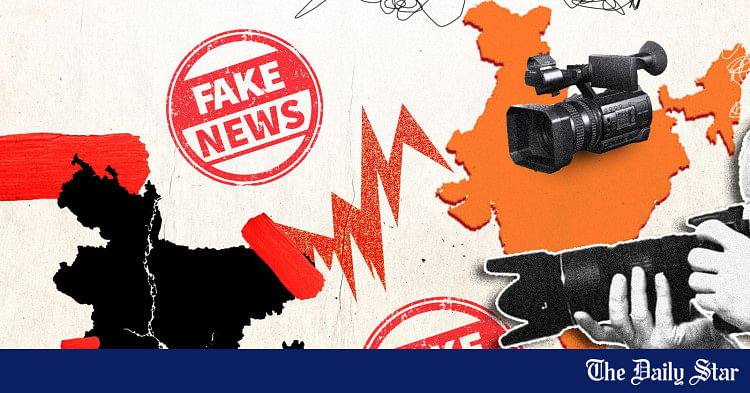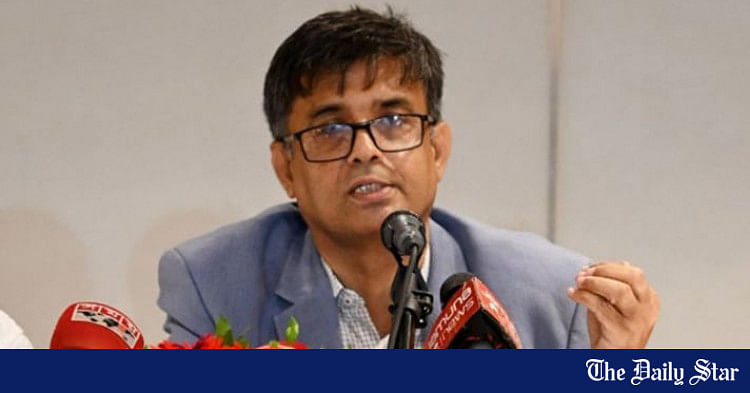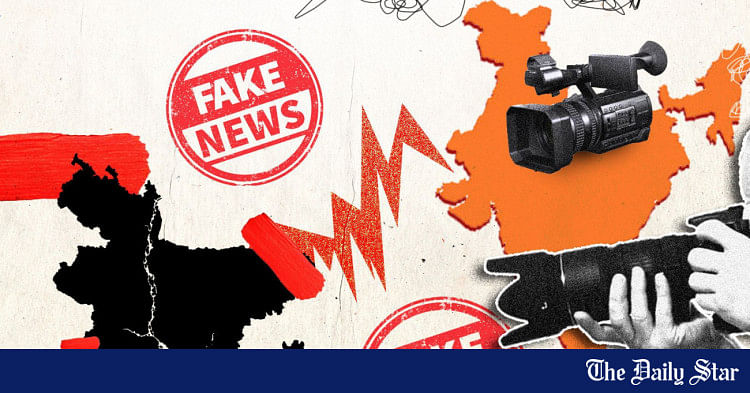Saif
Senior Operative
- 13,242
- 7,264
- Origin

- Axis Group

- Copy to clipboard
- Thread starter
- #41

49 Indian media outlets spread fake reports
As many as 49 Indian media outlets spread at least 13 false reports about Bangladesh between August 12 and December 5, 2024, according to an investigation by Rumor Scanner, a Bangladeshi fact-checking organisation.
49 Indian media outlets spread fake reports
Finds Rumor Scanner

Photo: Collected
As many as 49 Indian media outlets spread at least 13 false reports about Bangladesh between August 12 and December 5, 2024, according to an investigation by Rumor Scanner, a Bangladeshi fact-checking organisation.
In a report titled "Spread of Fake News About Bangladesh in Indian Media Outlets" published on its website yesterday, Rumor Scanner debunked the false claims and identified the media outlets responsible for spreading the misinformation.
Google News LinkFor all latest news, follow The Daily Star's Google News channel.
According to Rumor Scanner, since the fall of the Awami League-led government on August 5, Indian media outlets have been circulating a series of rumours about the situation in Bangladesh.
Republic Bangla topped the list of Indian media outlets with most false reports about Bangladesh by broadcasting five rumours. The Hindustan Times, Zee News, and Live Mint each spread three false reports. Meanwhile, Republic, India Today, ABP Anand, and Aaj Tak each broadcast two false reports. The remaining 41 media outlets spread one false report each.
The debunked claims included: a fake letter from Sheikh Hasina after her resignation; a video of a Muslim man falsely claimed as Hindu during a search for his son; false reports about Bangladesh's Chief Adviser Muhammad Yunus's health and location; baseless claims of withdrawal of bans on militant groups; arms smuggling via a ship from Pakistan; misrepresentation of lawyer Saiful Islam's murder; alleged ban on Indian TV channels; idol immersion in India misrepresented as a reaction to attacks on Hindu idols in Bangladesh; an alleged attack on a Shyamoli Paribahan bus from India; and false UK travel advisories for Bangladesh.
According to the fact-checking organisation, soon after Hasina fled and took refuge in India, the Indian media circulated an alleged open letter from her blaming the US for her removal. However, Rumor Scanner confirmed no such letter existed. It originated from a Facebook post and was published by a page, "Tripura Bhobishyot".
It also debunked a viral video that was broadcast by an Indian news outlet claiming a Hindu man was protesting for his missing son. Rumor Scanner found the man, Babul Howlader, was Muslim. His son had been missing since 2013.
The Indian media also used a morphed photo to falsely report that Prof Yunus was admitted to ICU after he was sworn in as chief adviser, according to the Rumor Scanner. It also debunked an Indian media report that said Prof Yunus fled to France after Trump's November 5 presidential win. The photo with the story was taken on August 8 when Yunus returned home from France to take oath as the chief adviser.
Claims of bans being lifted on militant organisations were also baseless, as verified by Rumor Scanner.
On November 13, the Indian media reported that a Pakistani military ship docked at Chattogram port. Rumor Scanner confirmed it was a commercial vessel carrying goods.
After the arrest of Chinmoy Krishna Das Brahmachari, spokesperson for Sammilita Sanatani Jagaran Jote, for disrespecting the national flag, rumours spread about lawyer Saiful Islam Alif's murder. Indian media outlets claimed that Saiful was murdered for defending Chinmoy at court. However, this claim was incorrect. Chinmoy's lawyer was Subhashish Sharma, not Saiful.
Some Indian media claimed Indian satellite channels were shut down in Bangladesh, but Rumor Scanner confirmed they remain operational, as verified by the information ministry and the Cable Operators Association.
Another claim suggested that the Bangladesh Air Force, with Chinese support, planned Asia's second-largest airbase near the so-called Chicken Neck, aka the Siliguri Corridor. However, Rumor Scanner identified this news as false. Lalmonirhat airport, which has been unused for over six decades, saw no such activities as claimed by the report.
The fact-finding organisation identified a viral video claiming to show a temple attack in Bangladesh as fake. The video was taken in India during idol immersion.
Reports of anti-India slogans following a bus accident in Brahmanbaria were also identified as rumours by the Rumor Scanner.
UK travel advisories were falsely portrayed as Bangladesh-specific, whereas they applied to multiple countries, including India, with no heightened warnings for most of Bangladesh.
Finds Rumor Scanner
Photo: Collected
As many as 49 Indian media outlets spread at least 13 false reports about Bangladesh between August 12 and December 5, 2024, according to an investigation by Rumor Scanner, a Bangladeshi fact-checking organisation.
In a report titled "Spread of Fake News About Bangladesh in Indian Media Outlets" published on its website yesterday, Rumor Scanner debunked the false claims and identified the media outlets responsible for spreading the misinformation.
Google News LinkFor all latest news, follow The Daily Star's Google News channel.
According to Rumor Scanner, since the fall of the Awami League-led government on August 5, Indian media outlets have been circulating a series of rumours about the situation in Bangladesh.
Republic Bangla topped the list of Indian media outlets with most false reports about Bangladesh by broadcasting five rumours. The Hindustan Times, Zee News, and Live Mint each spread three false reports. Meanwhile, Republic, India Today, ABP Anand, and Aaj Tak each broadcast two false reports. The remaining 41 media outlets spread one false report each.
The debunked claims included: a fake letter from Sheikh Hasina after her resignation; a video of a Muslim man falsely claimed as Hindu during a search for his son; false reports about Bangladesh's Chief Adviser Muhammad Yunus's health and location; baseless claims of withdrawal of bans on militant groups; arms smuggling via a ship from Pakistan; misrepresentation of lawyer Saiful Islam's murder; alleged ban on Indian TV channels; idol immersion in India misrepresented as a reaction to attacks on Hindu idols in Bangladesh; an alleged attack on a Shyamoli Paribahan bus from India; and false UK travel advisories for Bangladesh.
According to the fact-checking organisation, soon after Hasina fled and took refuge in India, the Indian media circulated an alleged open letter from her blaming the US for her removal. However, Rumor Scanner confirmed no such letter existed. It originated from a Facebook post and was published by a page, "Tripura Bhobishyot".
It also debunked a viral video that was broadcast by an Indian news outlet claiming a Hindu man was protesting for his missing son. Rumor Scanner found the man, Babul Howlader, was Muslim. His son had been missing since 2013.
The Indian media also used a morphed photo to falsely report that Prof Yunus was admitted to ICU after he was sworn in as chief adviser, according to the Rumor Scanner. It also debunked an Indian media report that said Prof Yunus fled to France after Trump's November 5 presidential win. The photo with the story was taken on August 8 when Yunus returned home from France to take oath as the chief adviser.
Claims of bans being lifted on militant organisations were also baseless, as verified by Rumor Scanner.
On November 13, the Indian media reported that a Pakistani military ship docked at Chattogram port. Rumor Scanner confirmed it was a commercial vessel carrying goods.
After the arrest of Chinmoy Krishna Das Brahmachari, spokesperson for Sammilita Sanatani Jagaran Jote, for disrespecting the national flag, rumours spread about lawyer Saiful Islam Alif's murder. Indian media outlets claimed that Saiful was murdered for defending Chinmoy at court. However, this claim was incorrect. Chinmoy's lawyer was Subhashish Sharma, not Saiful.
Some Indian media claimed Indian satellite channels were shut down in Bangladesh, but Rumor Scanner confirmed they remain operational, as verified by the information ministry and the Cable Operators Association.
Another claim suggested that the Bangladesh Air Force, with Chinese support, planned Asia's second-largest airbase near the so-called Chicken Neck, aka the Siliguri Corridor. However, Rumor Scanner identified this news as false. Lalmonirhat airport, which has been unused for over six decades, saw no such activities as claimed by the report.
The fact-finding organisation identified a viral video claiming to show a temple attack in Bangladesh as fake. The video was taken in India during idol immersion.
Reports of anti-India slogans following a bus accident in Brahmanbaria were also identified as rumours by the Rumor Scanner.
UK travel advisories were falsely portrayed as Bangladesh-specific, whereas they applied to multiple countries, including India, with no heightened warnings for most of Bangladesh.







